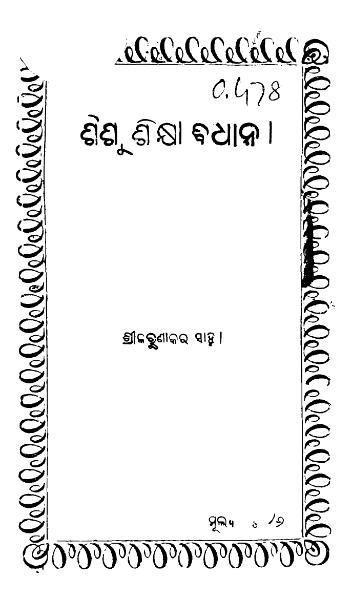In the early 20th century, as India grappled with the impacts of colonial rule and the quest for self-identity, the field of education began to witness significant transformations. One noteworthy contribution from this era is Shishu Shiksa Bidhana, authored by Karunakara Sahu and published in 1913. This textbook stands as a pioneering resource in the landscape of Odia education, specifically designed for the formative years of children, and embodies the values and aspirations of its time.
Shishu Shiksa Bidhana, which translates to Child Education Methodology, was created with the vision of establishing a strong educational foundation for young learners. Sahu recognized the critical importance of early childhood education in shaping future citizens, and this textbook reflects his commitment to pedagogical innovation. Through its thoughtful structure and content, the book aims to nurture the intellectual, emotional, and social development of children, preparing them for the complexities of life.
The textbook covers a wide range of subjects, emphasizing the holistic development of the child. Sahu’s approach integrates lessons in language, mathematics, science, and moral education, recognizing that a well-rounded education extends beyond mere academic knowledge. He meticulously outlines methods to engage young minds, employing storytelling, experiential learning, and interactive activities that make learning enjoyable and effective. This progressive outlook on education encourages curiosity and creativity, laying the groundwork for a lifelong love of learning.
One of the standout features of Shishu Shiksa Bidhana is its emphasis on moral and ethical education. Sahu understood that character-building is as essential as academic achievement. The textbook includes stories and parables that convey moral lessons, aiming to instill values such as honesty, compassion, and respect in the hearts of young learners. This holistic approach not only shapes knowledgeable individuals but also fosters responsible and conscientious citizens.
The language used in the textbook is another notable aspect. Sahu employs clear, simple, and engaging Odia, making the content accessible to children and teachers alike. By using the vernacular, he promotes the importance of mother-tongue education, recognizing that language plays a crucial role in cultural identity and understanding. This effort contributes to the preservation and elevation of the Odia language, reinforcing the connection between language and culture.
In addition to its educational impact, Shishu Shiksa Bidhana serves as a historical artifact that reflects the socio-cultural dynamics of Odisha in the early 20th century. The book highlights the aspirations of parents and educators during a time of awakening, where there was a collective desire to uplift society through education. It embodies the spirit of reform and the belief that education is a powerful tool for social change—a vision that resonates profoundly today.
Despite being over a century old, the principles outlined in Shishu Shiksa Bidhana remain relevant in contemporary educational discourse. In an age marked by rapid technological advancements and changing societal values, the focus on holistic education, character development, and the nurturing of creativity continues to be essential. Modern educators can draw inspiration from Sahu’s framework, adapting his insights to meet the needs of today’s learners.
Books Info
| Books name | Shishu Shiksa Bidhana / ଶିଶୁ ଶିକ୍ଷା ବିଧାନ |
| Author | Karunakara Sahu |
| No Of pages | 41 |
| Publisher | NA |
| Publication | 1913 |
| Printed At | NA |
| Distributor | NA |

